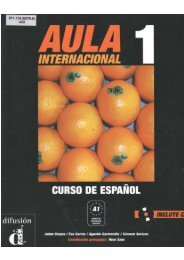III. The Beginnings of Transformation
III. The Beginnings of Transformation
III. The Beginnings of Transformation
You also want an ePaper? Increase the reach of your titles
YUMPU automatically turns print PDFs into web optimized ePapers that Google loves.
BEGINNINGS OF TRANSFORMATION<br />
toward Iconium, and in an effort to scorch the earth in the path <strong>of</strong> the<br />
Crusaders, they gained entrance into the Greek towns, pillaged the houses<br />
and churches, carried <strong>of</strong>f the livestock, silver, gold, and other booty, and<br />
then burned and destroyed everything that they could not carry away and<br />
that might have been <strong>of</strong> some use to the Latins. Later in his reign, the<br />
emperor Alexius I passed through the same areas and sought to destroy<br />
the Turkish encampments and to waste the area so that the Turks would<br />
not be able to use it to attack the empire. <strong>The</strong> sultan also scorched the<br />
earth about Iconium. As the region had become the border between<br />
Greek and Turkish possessions, it was slowly being turned to wasteland<br />
as a result <strong>of</strong> the frequent military campaigns and by express desire <strong>of</strong><br />
both sides so that invaders might not find sustenance in these regions. 28<br />
As Phrygia remained a critical frontier area in the reigns <strong>of</strong> John and<br />
Manuel, it suffered considerably from Turkish raiding, 29<br />
but with the<br />
battle <strong>of</strong> Myriocephalum it was largely lost to the Turks. Pamphylia and<br />
Pisidia had a fate similar to that <strong>of</strong>Phrygia. After the initial recovery<strong>of</strong>the<br />
area by Alexius and John, the Turks raided and expanded into the region,<br />
until by 1204 little outside Attaleia remained Byzantine. 30<br />
In the mid-<br />
twelfth century the fertile agricultural area <strong>of</strong> Attaleia was so unsafe<br />
because <strong>of</strong> the Turks that the inhabitants had to import their grain by<br />
sea. 31<br />
<strong>The</strong>re are indications that Lycia and Caria also saw repeated<br />
waves <strong>of</strong>incursions. 32<br />
Though the contemporary narratives give only a partial account <strong>of</strong> the<br />
events and situation in western Anatolia, these are sufficient to indicate<br />
that the invasions and warfare brought considerable upheaval to the<br />
western Anatolian districts <strong>of</strong> Bithynia, Mysia, Lydia, Caria, Ionia,<br />
Lycia, Phrygia, Pamphylia, and Pisidia. <strong>The</strong> majority <strong>of</strong> the raids have<br />
remained unchronicled, for the Seljuks at this time had nothing in the way<br />
<strong>of</strong>chronicles (at least chronicles that have survived), and the Byzantine<br />
historians were too concerned with the capital to note the recurring<br />
raids. It is to be assumed that the border raids <strong>of</strong> the Turkmens were<br />
constantly operative, and in fact the language <strong>of</strong> the Byzantine chronicles<br />
states this explicitly. 33<br />
<strong>The</strong> disruption and destruction <strong>of</strong>ten brought by<br />
the Turkish raids to Byzantine urban and rural society in western Asia<br />
Minor were extensive, and a number <strong>of</strong> authors refer to this phenomenon<br />
in very general terms. Anna Comnena speaks <strong>of</strong> the Turkish "satraps"<br />
28<br />
Gesta Francorum, pp. 54-55. Alexius burned Turkish settlements wherever he found<br />
them in order to protect his lands from the Turkmen raids, William <strong>of</strong> Tyre, VI, xii.<br />
Alexius had the villages <strong>of</strong> Bourtzes burned because <strong>of</strong> the Turks, and then removed all<br />
the Greeks, Anna Comnena, <strong>III</strong>, 200-203. Tudebodus, R.H.C., O.C., <strong>III</strong>, 29.<br />
2 9<br />
<strong>The</strong>odore Scutariotes-Sathas, 190. Nicetas Choniates, 71-72. Cinnamus, 179.<br />
3 0<br />
<strong>The</strong>odore Scutariotes-Sathas, 190-191, 208. Nicetas Choniates, 50, 689.<br />
3 1<br />
William <strong>of</strong> Tyre, XVI, xxvi.<br />
32<br />
Miklosich et Muller, VI, 17, 19, 84, 87; IV, 323-329, where it is implied that the<br />
destruction <strong>of</strong> Latrus at the end <strong>of</strong> the eleventh was repeated again in the twelfth century.<br />
3 3<br />
Cinnamus, 59-60. Nicetas Choniates, 551.<br />
148






